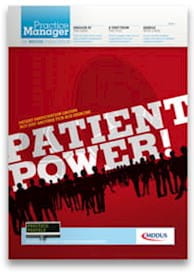PATIENT choice has become something of a buzz-phrase recently as the NHS undergoes major changes.
“Respecting and involving patients” is one of the requirements of registration with the Care Quality Commission in England and, with that in mind, the BMA’s General Practitioners Committee has advised medical practices to have a “patient participation scheme” in place.
Many practices may already feel overwhelmed by paperwork and the thought of setting up a patient participation group (PPG) may seem like just another box-ticking exercise.
But, done well, PPGs can be an excellent way of involving people in local healthcare decision-making and can provide valuable feedback. By choosing the right people they can help practices better respond to patients’ wants and needs and improve practice-patient relations.
PPGs can be found across the UK in both medical and dental practices, with more than half of English medical practices operating one. PPGs do operate in Scotland although they are not a contractual or statutory requirement. The Scottish Health Council promotes the benefits of PPGs as a means of public involvement and recently published practical guidance regarding the scheme. A 2010 NHS circular containing recommendations on engaging with patients states that general practices “should be able to demonstrate that patient or other lay involvement is welcomed and enabled in all aspects of the delivery and planning of services.”
GETTING STARTED
The National Association for Patient Participation (NAPP) is an umbrella organisation for patient-led groups within UK general practices. They define a PPG as a group of people who “work with their practices to provide practical support, to help patients to take more responsibility for their own health and to provide strategic input and advice. They are based on cooperation between the practice staff and patients. They help to improve communication.”
Guidance on setting up a PPG makes clear that a key element of success is that the group is representative of the patient population in terms of age, gender, race, physical abilities and so on. Look for motivated people with useful skill sets who are willing to share decision-making in the running of the practice and not those simply interested in attending for coffee and a chat.
A structure must also be in place for regular engagement and the group should have a strategic and overarching focus. Every PPG is different and can choose which direction it wishes to take, whether to focus purely on strategic input or to include wider issues such as improving communication and promoting good health.
A PPG scheme tends to involve regular face-to-face meetings which should ideally be attended at times by a GP and/or practice manager (particularly for the first few meetings). They can also be virtual, where contact is made with a patient group via email. Whatever the format, make clear from the start that the group is not a forum for pursuing individual personal complaints or single issue campaigns. Areas of priority should be agreed with short, medium and long-term objectives – a few worthwhile short-term objectives can provide ‘quick wins’ and help boost confidence. Patient views can be collected through surveys on various topics and the results should be publicised alongside any achievements and actions taken.
GIVING PURPOSE
PPGs can be used for various purposes: offering suggestions on improving disabled access to the surgery, ap- pointment systems, consultation times, buying new toys for the waiting room or maintaining plants. They can help obtain patient views, for example where two practices are merging, and can also highlight the need for patient support in terms of bereavement counselling, a carers group, hospital visiting or befriending of housebound patients.
Last year Wilsden Medical Practice in Bradford won the NAPP’s PPG of the year award. Formed in 2010, the 10-strong group are aged between 40 and 80 and include wheelchair users, minority ethnic groups and parents with young children. They meet monthly and have provided feedback on issues such as telephone appointments and extended opening hours as well as offering an insight into the general ‘patient experience’ at both Wilsden and the practice’s other site, Cullingworth Medical Practice.
Practice manager Susan Crowther says the PPG has made it easier for patients to share comments and con- cerns and has even lightened the practice workload.
She says: “The group attended an open flu clinic recently and helped recruit 50 patients who were willing to be seen by our trainee doctors. On another occasion, we used the group to carry out a survey on our telephone service which helped us discover if there were key times where staffing levels affected service delivery.
He says: “In a practice which is solely guided by faith, the practice manager would clearly have an important role in policy issues. There may also be a need to operate a different timetable; for example a religious Jewish practice which will have been closed from before the onset of the Sabbath on a Friday afternoon in December might be expected to have consulting on a Sunday morning.”
“It’s often the case that the group will do work that would normally be done by me or the other practice staff, so it’s saving us time.” Susan says the key to success is communication. She and a GP partner meet with the PPG to set objectives for the following 12 months. The practice is now setting up a virtual PPG where more than 100 patients have agreed to offer comments and suggestions by email. Susan adds: “The virtual PPG is a great way for the practice to communicate with patients, especially those who are not often in the practice. With 10,000 patients you need different ways of promoting what you do, other than just posters and flyers.”
PATIENT VOICE
Amblecote Dental Care in the West Midlands set up its group in 2011 which meets every two to three months.
PPG liaison and receptionist Jayne Vallance says the group plays an important role. “We keep them informed with changes like staffing and new equipment, and they give us valuable feedback,” she says. “Recently, there were concerns one of the patient letters was unclear so we asked the PPG to review it and then re-worded it based on their suggestions.”
Following another of the group’s suggestions, an Amblecote dentist gave a talk about oral health at local schools. The PPG has also helped the practice carry out customer satisfaction surveys.
Jayne adds: “We like to think they are the patient voice and they are asking questions for the wider benefit, not just for themselves.”
Nairn Healthcare Group in the Scottish Highlands set up Nairn Patients Group in April 2012 following a practice merger, with updates publicised on their new web (www. nairnpatientsgroup.org.uk) and Facebook pages (www. facebook.com/NairnPatientsGroup).
Practice manager Barbara Graham says the process has been a learning curve. “It has been very stressful setting up the PPG and with hindsight I would’ve done some things differently,” she says.
“I firmly believe it’s an invaluable resource but I failed to make clear from the start exactly what the practice expected from the group and also that it’s not a forum for personal grievances.
“Things are improving and now the PPG operates the Facebook and web pages which are a phenomenally useful way to communicate with patients, particularly when, for example, our phone lines went down recently. There are so many great resources out there, like the NAPP and RCGP websites, and it’s vital to seek advice before starting a PPG.”
KEY POINTS
Remember: keep communication lines between the practice and PPG open, set ground rules and stick to them, ensure the group maintains focus and direction (plan ahead if possible), and source a varied group of active and interested volunteers. Get support from the doctors/dentists and practice staff and consider enlisting help from key members of the community (local councillors, school headteachers) who can help raise the group’s profile and widen its focus.
LINKS
- National Association for Patient Participation www.napp.org.uk
- Scottish Health Council www.scottishhealthcouncil.org
Joanne Curran is an associate editor of Practice Manager
This page was correct at the time of publication. Any guidance is intended as general guidance for members only. If you are a member and need specific advice relating to your own circumstances, please contact one of our advisers.
Read more from this issue of Practice Manager

Save this article
Save this article to a list of favourite articles which members can access in their account.
Save to library
